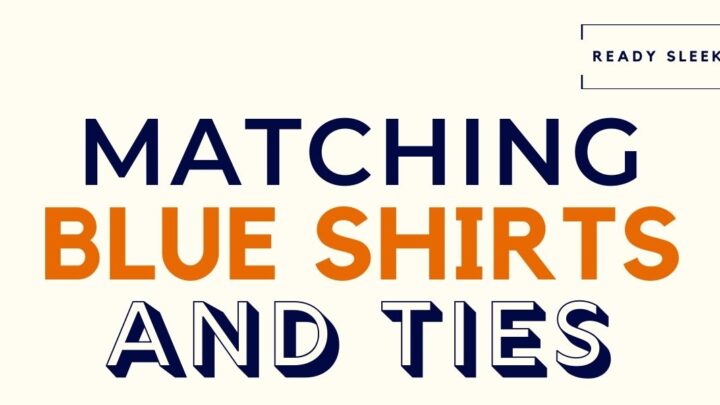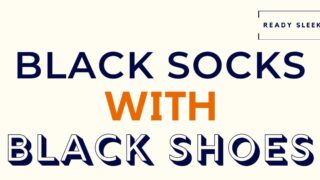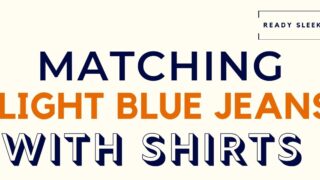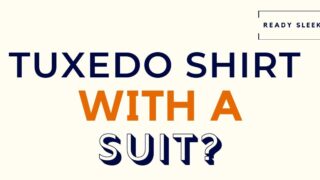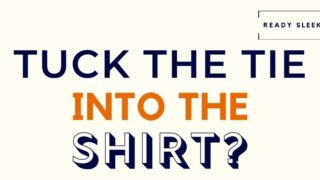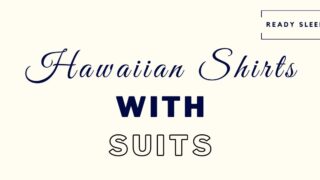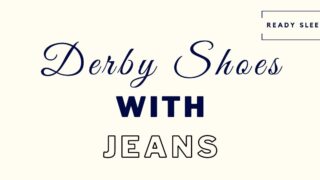Color matching ties and shirts isn’t always as easy as it seems at first. The combination you choose really does depend on where you’re going and what you’re doing. Having said that, what color tie can you wear with a blue shirt?
A blue shirt can be worn with a navy blue tie for a monochromatic look or a neutral-colored tie such as slate grey or black instead. Wearing the “cool” colored blue shirt with a “warm” colored tie such as burgundy red would produce a nice sense of visual contrast.
Although that’s the short answer, there’s more to it.
After going through the key rules you should stick to whenever you’re color-coordinating blue shirts and ties, I’ll go through some great combinations you can try out for yourself.
Let’s get to it.
Matching Blue Shirts With Ties – The Rules
Having a set of “rules” does always make things easier. It makes decisions a whole lot easier.
“Rules”, “guidelines, “principles” – whatever you want to call them, these four should see you through every time.
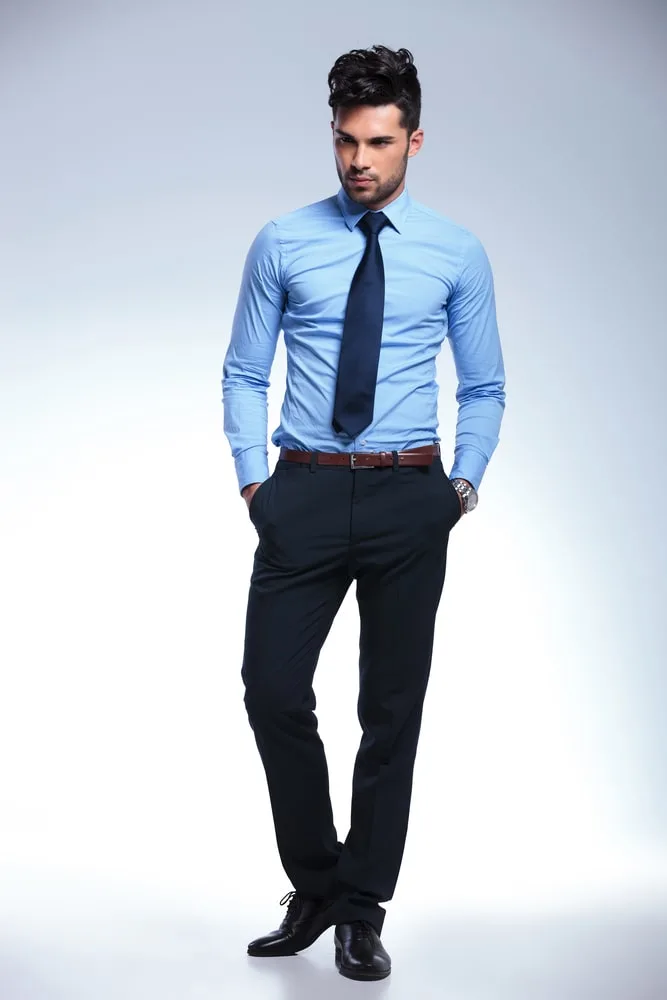
1. Keep The Tie Darker Than The Shirt
Try to pick a tie color that’s darker than the blue shirt behind it.
I’d say this tip was the most important because it really reduces the risk of things going wrong.
Having the tie stand out from the shirt due to being a distinctly darker color or shade just has a more conventional appearance to it.
If you’re going for a formal outfit, this is definitely a good thing.
But even if you were going for a more casual or social outfit, it will still usually look better than having the tie lighter than the blue shirt.
The easiest way to achieve this would be to pick a light blue shirt (eg. sky blue or pale blue).
But if you did choose a shirt in a darker shade of blue such as navy, try to pick a tie that’s even darker.
2. Consider The Formality
When going through the 5 blue shirt and tie combinations I’ve picked out down below, you’ll notice that some look more formal than others.
Here are the main factors to remember:
- The more contrast there is between the shirt color and the tie color, the more casual it’ll look
- Neutral colors will always look more formal
So, if you want a more formal blue shirt and tie combination, go for either a monochromatic color scheme (eg. light blue shirt with navy blue tie) or a neutral colored tie (eg. blue shirt with grey or black tie).
Check out the first two combinations later on for examples.
3. One Pattern Only
While it’s definitely possible to wear a patterned blue shirt with a patterned tie, it’s a little more technical and harder to get right.
There’s just more of a risk of the combination looking too “busy” and crowded, with the two patterns potentially conflicting with each other.
To keep things simple, if you want to wear a patterned item, go for either a patterned tie or a patterned blue shirt. Not both.
4. Know The Color Wheel
The color wheel gets a bad rep sometimes, but that’s mainly because people overcomplicate it and turn it into a boring, endless lecture.
The bottom line here is that the color wheel is useful when it comes to color coordinating men’s clothes, but only in certain ways.
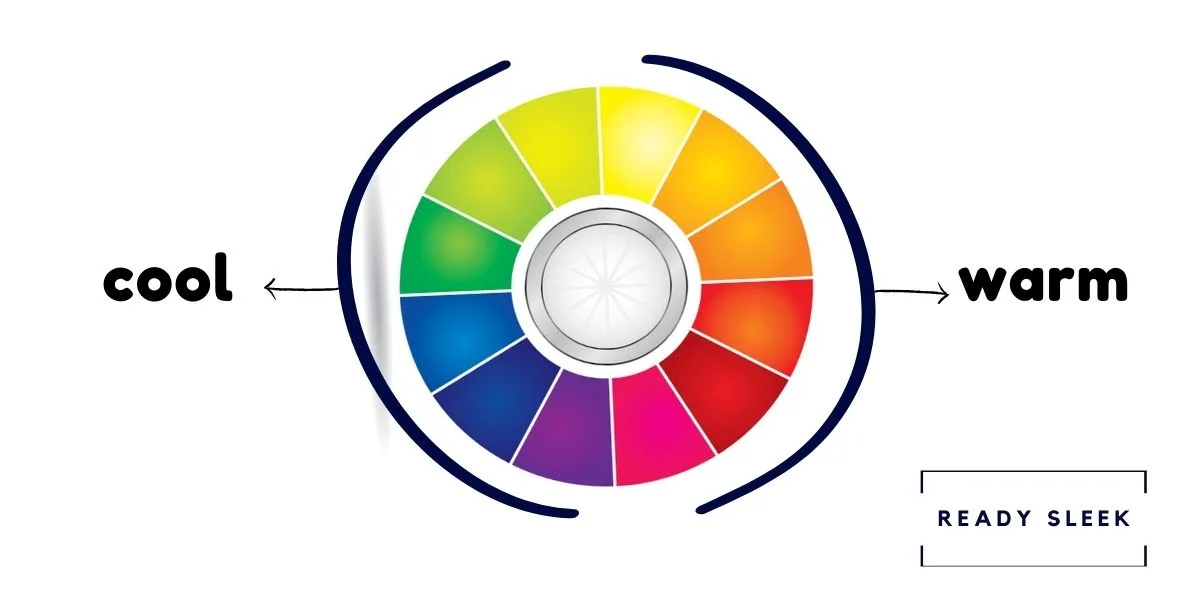
Here are the cliff notes:
- The color wheel shows the relationship between colors.
- It can be split into two halves – “warm colors” and “cool” colors.
- “Cool” colors are more winter/fall associated and have a calm, soothing feel to them. Examples are blues, greens, and purples.
- “Warm” colors are more summer-associated and have a vibrant and upbeat look and feel to them. Examples are reds, oranges, and yellows.
- The wheel is useful because you can use it to combine shirts and ties in similar hues together to create less contrast or combine shirts and ties in hues further apart on the color wheel to produce more contrast.
Both the color wheel and color “temperatures” (warm and cool) will make even more sense when we go through the blue shirt and tie combinations below.
Ultimately, blue is a “cool” color and that’s important when it comes to color matching.
5 Blue Shirt And Tie Combinations
Here are some options. Notice how the first two (monochromatic and neutral) have the most formal look to them, while the other three have a more smart-casual look to them.
This is mainly to do with how much contrast there is between the blue shirt and the tie it’s paired with.
Monochromatic Blue Shirt And Tie
Example: Sky Blue Shirt With Navy Blue Tie
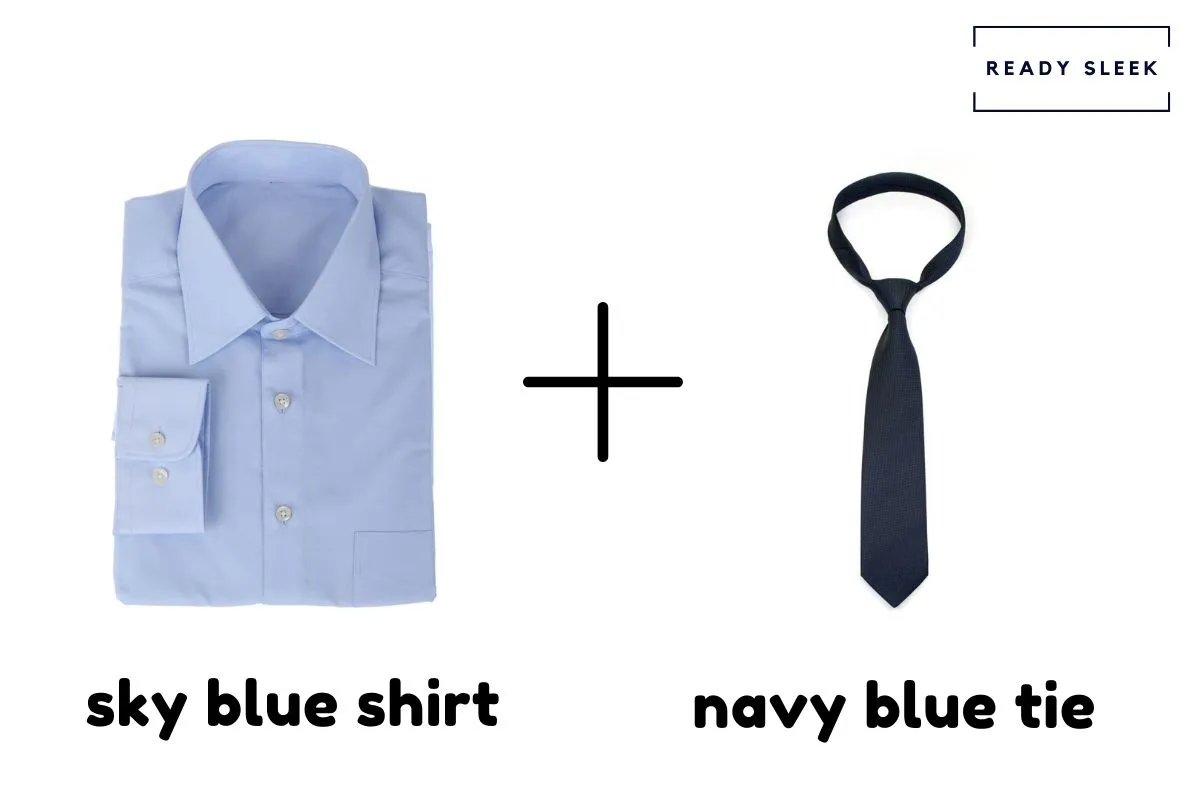
“Monochromatic” doesn’t mean choosing a blue shirt and a blue tie in exactly the same shade.
You want the tie to be noticeably darker than the shirt to create enough contrast for the two to easily be separated from each other visually.
However, because the two items are still on the same “blue” spectrum, there isn’t really very much contrast between them.
In many ways, this makes things pretty easy. You can pair any blue shirt with any blue tie and it would usually work, as long as one is darker than the other.
Going back to our key “rules” listed earlier, things usually go a lot smoother when the shirt is lighter than the tie.
Putting all of this together, wear a light blue shirt (eg. sky blue) with a dark blue tie (eg. navy blue) for a great monochromatic outfit.
As there isn’t much contrast between the two items, it has an effortlessly formal feel to it.
Ideal for more formal or business-professional settings where you don’t want a shirt and tie combo that’s in-your-face or striking.
Blue Shirt + Neutral-Colored Tie
Example: Pale Blue Shirt With Slate Grey Tie
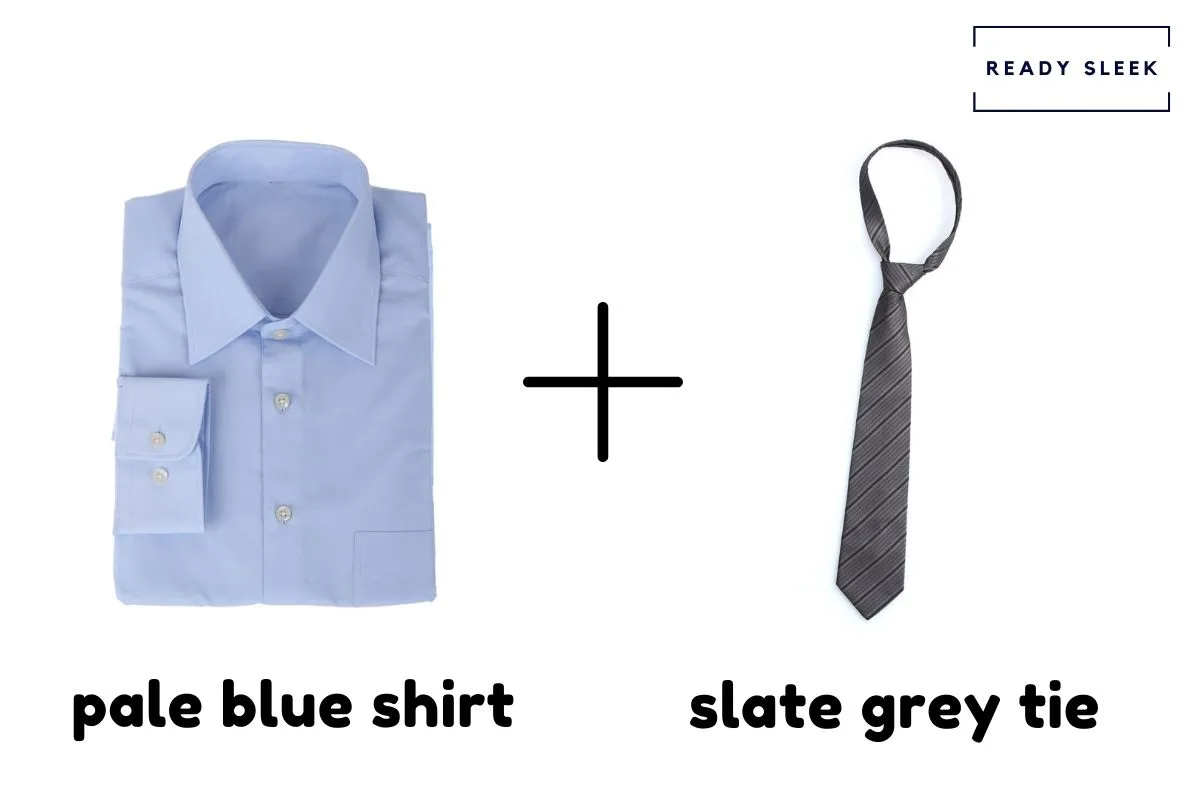
You could wear a blue shirt with any truly “neutral” colored tie and it would work.
The true neutral colors are grey, white, and black.
There are, however, other colors that are considered neutral but aren’t actually neutral.
They’re considered neutral because they’re very muted, subtle, and incredibly easy to pair with other colors.
These “fringe” neutral colors include khaki brown, olive green, and navy blue.
When it comes to color matching blue shirts with ties, including these additional neutral colors is still usually a good idea and worth experimenting with.
But just to keep things simple, let’s just use grey, white, and black as examples here.
These colors are so neutral that you could wear any of them with any color of shirt and it would work.
Just like with the monochromatic color scheme in the first combination, it really does take the thinking out of your decision.
Simply pair any blue shirt with a grey, white, or black tie and it would work.
However, going back to that all-important guideline of picking a shirt that’s lighter in color than your tie, going for a darker shade of grey (eg. charcoal/slate) or black would usually be better options here.
If you did want to experiment with the (kinda) neutral colors of khaki brown and olive green for your ties, it would usually work well too.
Blue Shirt + Cool-Colored Tie
Example: Light Blue Shirt With Hunter Green Tie
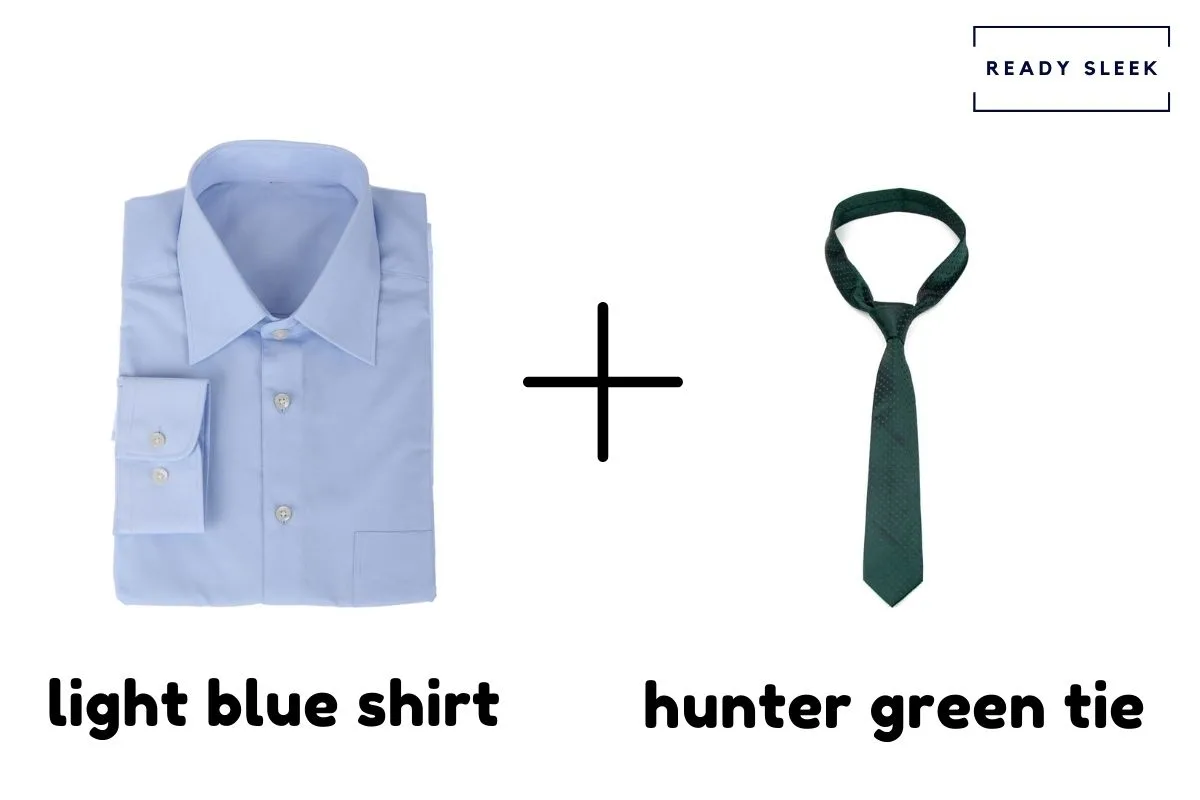
Here we make use of the fact that blue is a cool color (in terms of color temperature). It has a soothing and calm feel to it. It’s also on the “cool” half of the color wheel.
Cool colors are easy to combine with other cool colors.
What you’ll get is a shirt and tie combination that has more contrast than a monochromatic/neutral color scheme, but is still subtle enough to work pretty well in more formal settings.
It’s a great option but does require a little more thought than the first two combinations.
Looking at the color wheel, other “cool” colors that lie close to blue are greens and purples.
Either of these would work perfectly well, especially when the shade of green or purple is darker than the shade of blue shirt you’ve gone for.
The example above is of a light blue shirt with a hunter green tie. Both colors are “cool” and the result is pretty calm and relaxed.
Not too bold, not too striking, but well-coordinated and stylish.
If you wanted to go for a purple tie instead, “plum” purple works pretty well because it’s dark.
It may not be suitable for truly formal or business-professional outfits. But it would work very well in business-casual and smart-casual settings.
Blue Shirt + Warm-Colored Tie
Example: Blue Shirt With Burgundy Red Tie
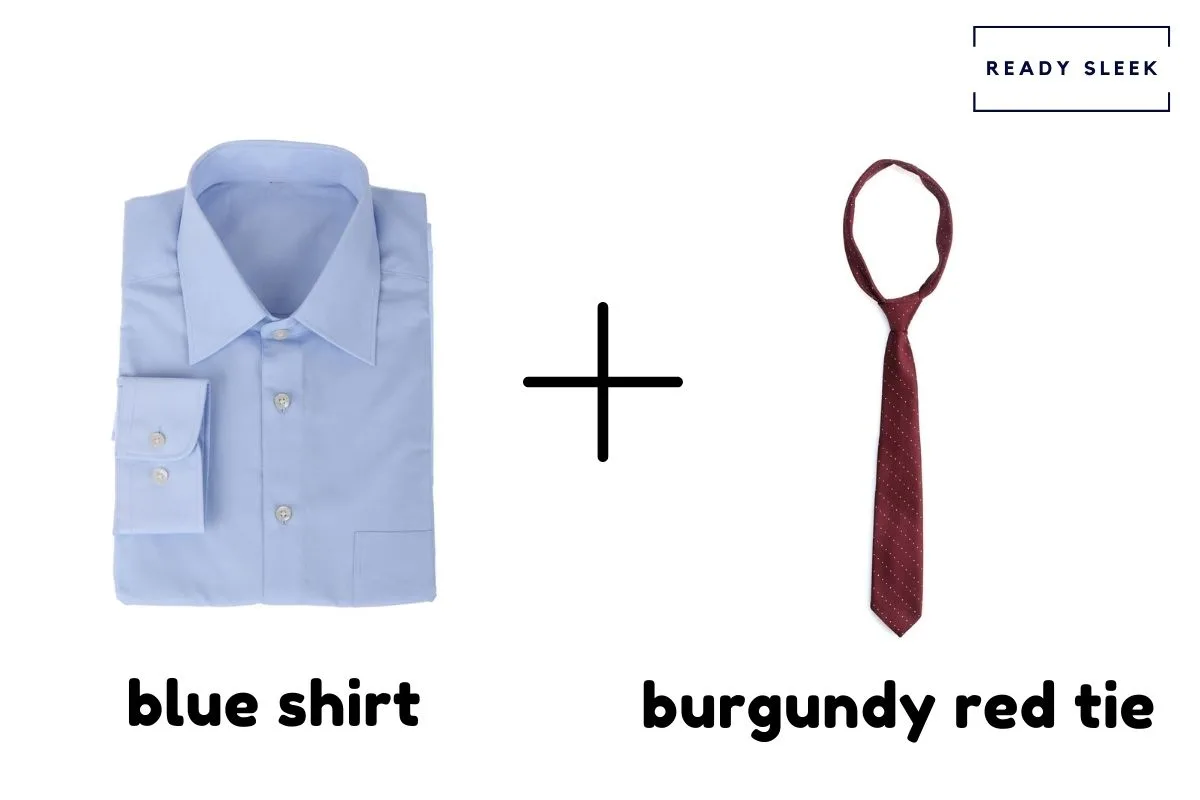
Things get even more interesting here. We’ve established that blue is a “cool” color. Pairing it with a “warm” colored tie will create a nice sense of balance, harmony, and contrast.
The contrast, however, will make the combination look more casual than the three previous blue shirt and tie combinations.
Going back to the glorious color wheel, we can see that the “warm” half includes reds, oranges, and yellows.
Choosing a tie in a hue of one of these colors and wearing it over a blue shirt can look great.
The example I’ve gone for here is a light blue shirt with a burgundy red tie.
Burgundy red will always work well here because it’s clearly “warm”, but still dark enough to be darker than most blue shirts you’ll wear with it.
The contrast you’d get is large enough for the combination to be more appropriate in more casual settings and dress codes such as smart-casual and business-casual.
Blue Shirt + Complimentary Tie
Example: Blue Shirt With Marigold Orange Tie
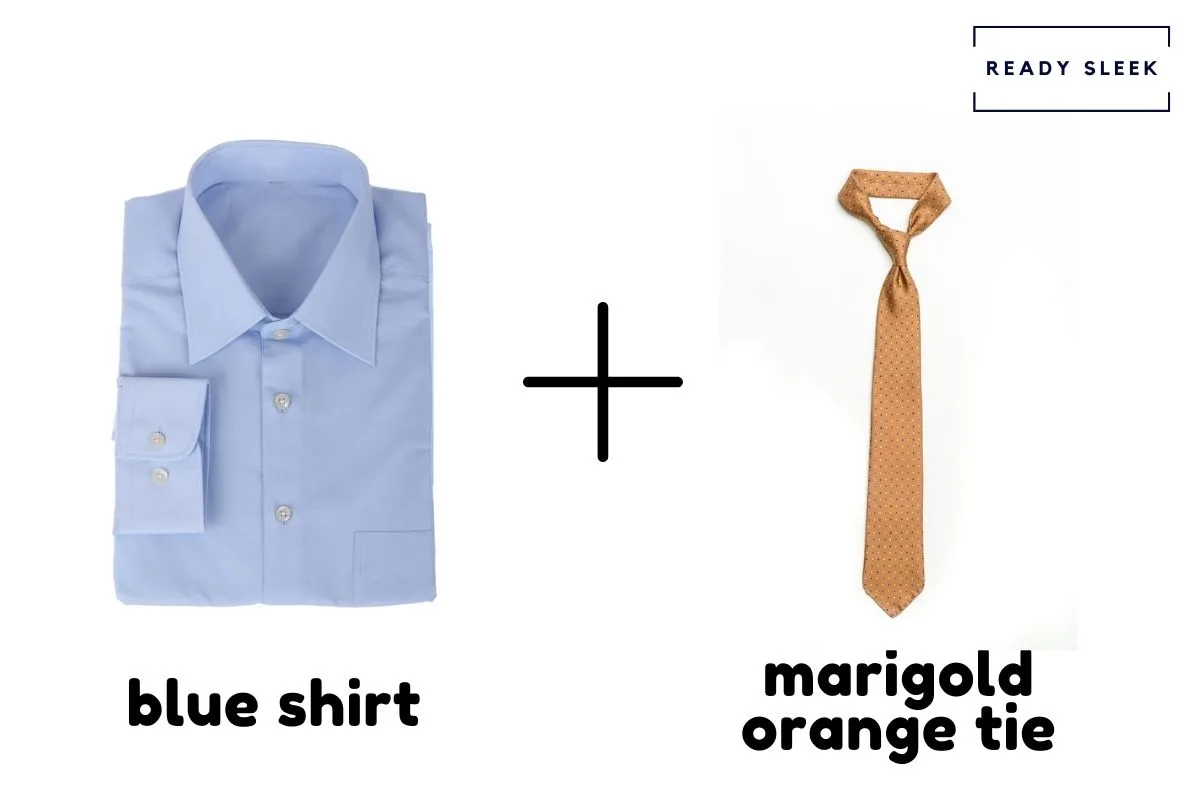
“Complimentary” colors are those that sit directly opposite each other on the color wheel.
These colors have the maximum amount of contrast and will produce a striking and bold effect when they’re combined.
The tie will really stand out from the shirt and vice versa. It’s eye-catching and in-your-face. That’s part of the appeal.
However, it’ll have a very casual appearance to it.
It’s a good option if you’re looking to make more of a statement.
Looking at the color wheel, you can see that blue and orange are pretty much opposite each other on the color wheel.
So, try pairing a light blue shirt with a marigold orange tie like in the picture above. It has a pretty vibrant and summery feel to it. It won’t appeal to everyone, but it’ll definitely stand out from the crowd.
If you’re looking for some contrast between your blue shirt and tie but not this much contrast, consider pairing the blue shirt with a warm-colored tie that sits a little closer on the color wheel. If this is for you, the previous combo would be a better option.
Frequently Asked Questions
Here are the answers to a couple of FAQs on this topic to really round things up nicely.
What Color Tie Goes With A Blue Shirt And Specific Suit Colors?
The easiest suit colors to combine with shirts and ties are navy blue, grey, and black. These colors are neutral enough to work with any shirt/tie colors you can think of.
So, what color tie should you wear with a blue shirt and these specific suit colors?
Well, as long as you stick to one of the five combination formats I went through in the previous section, it really doesn’t matter.
Go for a monochromatic or neutral scheme, pair cool colors, combine warm and cool colors – when you go for a neutral suit color it really doesn’t matter.
It’ll work.
But let’s use some specific examples.
| Blue Shirt And Navy Suit | Burgundy red or royal blue tie |
| Blue Shirt And Grey Suit | Plum purple or black tie |
| Blue Shirt And Black Suit | Charcoal grey or forest green tie |
But these options can be mixed and matched. You could wear a plum purple or black tie with a navy, grey, or black suit and it would work.
That’s the beauty of it.
All you need to do is stick to one of the 5 combination formats from the previous section and you’ll be fine. Just take the formality of the setting you’re going to when making your decision.
Remember, the more contrast you’ve got, the more casual it’ll look.
Can You Wear A Black Tie With A Blue Shirt
You can easily wear a black tie with a blue shirt because black is a neutral color and easy to pair with other colors. A black tie and blue shirt would be suitable for formal and business-professional settings.
This combination is pretty hard to go wrong with. It’s a good one if you didn’t want to think too hard about color matching and coordination.
It’s just one you know will work.
Conclusion
There you have it.
A quick and easy guide to color-matching blue shirts with ties. It’s hard to go too far wrong, but there will always be certain color combinations that work better for the specific setting you’re attending.
Enjoy.
Ready Sleek founder. Obsessed with casual style and the minimalist approach to building a highly functional wardrobe. Also a fan of classic, vintage hairstyles.

